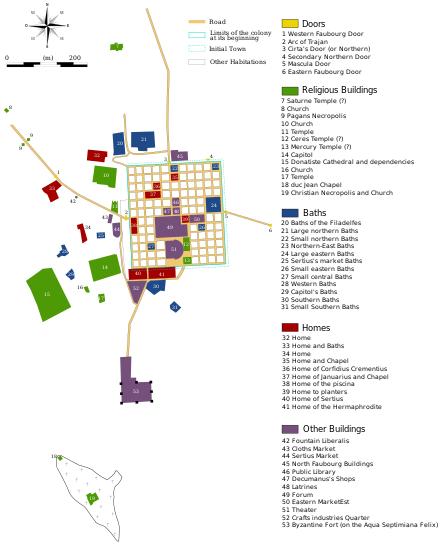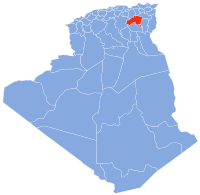Timgad
تيمقاد | |
 The Roman ruins of Timgad | |
| Alternative name |
|
|---|---|
| Location | Batna Province, Algeria |
| Region | Maghreb |
| Coordinates | 35°29′03″N 6°28′07″E / 35.48417°N 6.46861°E |
| Type | Settlement |
| History | |
| Founded | 100 CE |
| Abandoned | 7th century |
| Periods | Roman Empire |
Arab States | |
Timgad (
Located in modern-day
Name
In the former name of Timgad, Marciana Traiana Thamugadi, the first part – Marciana Traiana – is Roman and refers to the name of its founder, Emperor Trajan and his sister Marciana.[1] The second part of the name – Thamugadi – "has nothing Latin about it".[2] Thamugadi is the Berber name of the place where the city was built, to read Timgad plural form of Tamgut, meaning "peak" or "summit".[2]
History
The city was founded as a military
The city enjoyed a peaceful existence for the first several hundred years and became a
In the
Travelling Northern Africa, British explorer
Description

Located at the intersection of six roads, the city was walled but not fortified. Originally designed for a population of around 15,000, the city quickly outgrew its original specifications and spilled beyond the orthogonal grid in a more loosely organized fashion.
At the time of its founding, the area surrounding the city was a fertile agricultural area, about 1000 meters above sea level.
The original Roman grid plan is magnificently visible in the orthogonal design, highlighted by the
At the west end of the decumanus rises a 12 m high triumphal arch, called the Arch of Trajan, which was partially restored in 1900. The arch is principally of sandstone, and is of the Corinthian order with three arches, the central one being 11' wide. The arch is also known as the Timgad Arch.
A 3,500-seat theater is in good condition and is used for contemporary productions. The other key buildings include four thermae, a library, and a basilica.
The Capitoline Temple is dedicated to Jupiter and is of approximately the same dimensions as the Pantheon in Rome. Nearby the capitol is a square church, with a circular apse dating from the 7th century CE. One of the sanctuaries featured iconography of (Dea) Africa.[11] South of the city is a large Byzantine citadel built in the later days of the city.
Library

The Library at Timgad was a gift to the Roman people by Julius Quintianus Flavius Rogatianus at a cost of 400,000
The library occupies a rectangle 81 feet (25 meters) long by 77 feet (23 meters) wide.[12] It consists of a large semi-circular room flanked by two secondary rectangular rooms, and preceded by a U-shaped colonnaded portico surrounding three sides on an open court.[12] The portico is flanked by two long narrow rooms on each side, and the large vaulted hall would have combined the functions of a reading room, stack room, and perhaps a lecture room.[12] Oblong alcoves held wooden shelves along walls that would likely have been complete with sides, backs and doors, based on additional evidence found at the library at Ephesus.[12]
It is possible that free-standing bookcases in the center of the room, as well as a reading desk, might also have been present.[12] While the architecture of the Library at Timgad is not especially remarkable, the discovery of the library is historically important as it shows the presence of a fully developed library system in this Roman city, indicating a high standard of learning and culture. While there is no evidence as to the size of the collection the library harbored, it is estimated that it could have accommodated 3,000 scrolls.[12]
World Heritage Site
Timgad was inscribed as a World Heritage Site by UNESCO in 1982.
Gallery
- Ruins of Timgad, February 24, 1928
See also
References
- ISBN 9789947972250.
- ^ a b Gascou, Jacques (9 August 1972). "La politique municipale de l'empire romain en Afrique proconsulaire de Trajan à Septime-Sévère". Publications de l'École française de Rome. 8 (1): 97–100.
- ISBN 978-1-4443-5001-2.
- ISBN 978-0-7440-8586-0.
- ^ "Buried in Sand for a Millennium: Africa's Roman Ghost City". Messy Nessy Chic. 15 January 2020. Retrieved 7 May 2020.
- ISBN 978-1-4514-1452-3.
- ISBN 978-0-8108-6621-8.
- ^ UNESCO World Heritage Centre. "Timgad". unesco.org.
- ^ Playfair, R. Lambert (Robert Lambert) (1877). Travels in the footsteps of Bruce in Algeria and Tunis : illustrated by facsimiles of his original drawings. Getty Research Institute. London : C. Kegan Paul.
- ^ Montoya, Rubén: The Sahara buried this ancient Roman city—preserving it for centuries at National Geographic, 30 July 2019.
- OCLC 79861941.
- ^ a b c d e f g h Pfeiffer, H. (1931). The Roman Library at Timgad. Memoirs of the American Academy in Rome, 9, 157–165.
External links
- UNESCO site on Timgad
- Great Buildings entry on Timgad
- Images of Timgad on Manar al-Athar digital heritage photography archive
- Photos of Timgad
- Information on Roman Africa
- Map Location of Timgad













